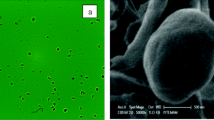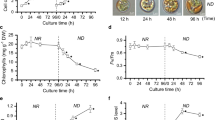Abstract
Natural carotenoids such as astaxanthin, β,β-carotene and lutein are pigments with a high market value. We studied the effects of nitrogen depletion on the carotenoid metabolism of Chlorella zofingiensis (Chlorophyta) and the subsequent treatment with diphenylamine (DPA), an inhibitor of the biosynthesis of secondary ketocarotenoids. Pigments were identified and quantified based on reversed phase ultra-high performance liquid chromatography photodiode array tandem mass spectrometry (RP-UHPLC-PDA-MSn). Nitrogen depletion (without DPA) resulted in a degradation of chlorophylls and primary carotenoids and an accumulation of astaxanthin, ketolutein, canthaxanthin, adonixanthin and β,β-carotene. The DPA treatment decreased the overall production of β,β-carotene derivatives (sum of astaxanthin, canthaxanthin, echinenone and adonixanthin); however, the production of ketolutein and degradation of primary carotenoids were not modified. This suggests that the regulatory mechanisms controlling the flux towards ketolutein and primary carotenoids were not affected by the decreased levels of β,β-carotene derivatives. In addition, DPA increased production of the individual carotenoids, adonixanthin and echinenone. Insight into the regulation of microalgal carotenoid biosynthesis as demonstrated in this paper is essential when a large-scale carotenoid production process is to be optimised or a recombinant C. zofingiensis strain is to be designed with the intention of excessively producing primary or secondary carotenoids.









Similar content being viewed by others
References
Bar E, Rise M, Vishkautsan M, Arad S (1995) Pigment and structural changes in Chlorella zofingiensis upon light and nitrogen stress. J Plant Physiol 146:527–534
Bauch ME (2011) Identifizierung und Quantifizierung der Ketocarotinoide in Dauerstadien von Grünalgen und Ketocarotinoidbiosynthese im Modellorganismus Chlamydomonas reinhardtii. Dissertation, Johannes Gutenberg University, Mainz
Breuer G, Lamers PP, Martens DE, Draaisma RB, Wijffels RH (2012) The impact of nitrogen starvation on the dynamics of triacylglycerol accumulation in nine microalgae strains. Bioresour Technol 124:217–226
Breuer G, Evers WAC, de Vree JH, Kleinegris DMM, Martens DE, Wijffels RH, Lamers PP (2013) Analysis of fatty acid content and composition in microalgae. J Vis Exp 80:e50628
Britton G (1995a) UV/visible spectroscopy. In: Britton G, Liaaen-Jensen S, Pfander H (eds) Carotenoids, vol 1B,Spectroscopy. Birkhäuser, Basel, pp 13–62
Britton G (1995b) Mass spectrometry. In: Britton G, Liaaen-Jensen S, Pfander H (eds) Carotenoids, vol 1B,Spectroscopy. Birkhäuser, Basel, pp 261–317
Britton G, Liaaen-Jensen S, Pfander H (editors) and Mercadante Z, Egeland E (compilers) (2004) Handbook, Carotenoid series. Birkhäuser, Basel
Collins AM, Jones HDT, Han D, Hu Q, Beechem TE, Timlin JA (2011) Carotenoid distribution in living cells of Haematococcus pluvialis (Chlorophyceae). PLoS ONE 6(9):e24302
Dall’Osto L, Lico C, Alric J, Giuliano G, Havaux M, Bassi R (2006) Lutein is needed for efficient chlorophyll triplet quenching in the major LHCII antenna complex of higher plants and effective photoprotection in vivo under strong light. BMC Plant Biol 6:32
Del Campo JA, Rodriguez H, Moreno J, Vargas MA, Rivas J, Guerrero MG (2004) Accumulation of astaxanthin and lutein in Chlorella zofingiensis (Chlorophyta). Appl Microbiol Biotechnol 64:848–854
Egeland G, Garrido J, Clementson L, Andresen K, Thomas C, Zapata M, Airs R, Llewellyn C, Newman G, Rodríguez F, Roy S (2011) Part VI: Data sheets aiding identification of phytoplankton carotenoids and chlorophylls. In: Roy S, Llewellyn CA, Egeland ES, Johnson G (eds) Phytoplankton pigments: characterization, chemotaxonomy and applications in oceanography. Cambridge University Press, Cambridge, pp 665–822
Enzell CR, Francis GW, Liaaen-Jensen S (1969) Mass spectrometric studies of carotenoids 2. A survey of fragmentation reactions. Acta Chem Scand 23:727–750
Falkowski PG, Raven JA (2007) Aquatic photosynthesis, 2nd edn. Princeton University Press, Princeton, 484 pp
Fan L, Vonshak A, Gabbay R, Hirshberg J, Cohen Z, Boussiba S (1995) The biosynthetic pathway of astaxanthin in a green alga Haematococcus pluvialis as indicated by inhibition with diphenylamine. Plant Cell Physiol 36:1519–1524
Frassanito R, Cantonati M, Flaim G, Mancini I, Guella G (2008) A new method for the identification and the structural characterisation of carotenoid esters in freshwater microorganisms by liquid chromatography/electrospray ionisation tandem mass spectrometry. Rapid Commun Mass Spectrom 22:3531–3539
Fucíková K, Lewis LA (2012) Intersection of Chlorella, Muriella and Bracteacoccus: resurrecting the genus Chromochloris Kol et Chodat (Chlorophyceae, Chlorophyta). Fottea 12:83–93
Goss R, Jakob T (2010) Regulation and function of xanthophyll cycle-dependent photoprotection in algae. Photosynth Res 106:103–122
Grünewald K, Hirschberg J, Hagen C (2001) Ketocarotenoid biosynthesis outside of plastids in the unicellular green alga Haematococcus pluvialis. J Biol Chem 276:6023–6029
Harker M, Young AJ (1995) Inhibition of astaxanthin synthesis in the green alga Haematococcus pluvialis. Eur J Phycol 30:179–187
Huang JC, Wang Y, Sandmann G, Chen F (2006) Isolation and characterization of a carotenoid oxygenase gene from Chlorella zofingiensis (Chlorophyta). Appl Microbiol Biotechnol 71:473–479
Jahns P, Holzwarth AR (2012) The role of the xanthophyll cycle and of lutein in photoprotection of photosystem II. Biochem Biophys Acta – Bioenerg 1817:182–193
Jin E, Lee CG, Polle JEW (2006) Secondary carotenoid accumulation in Haematococcus (Chlorophyceae): biosynthesis, regulation, and biotechnology. J Microbiol Biotechnol 16:821–831
Kanehisa Laboratories (2012) KEGG PATHWAY Database. Available at: http://www.genome.jp/kegg/pathway.html. Accessed 25 Jul 2013
Kliphuis AMJ, Janssen M, Van Den End EJ, Martens DE, Wijffels RH (2011) Light respiration in Chlorella sorokiniana. J Appl Phycol 23:935–947
Lamers PP, Janssen M, De Vos RCH, Bino RJ, Wijffels RH (2008) Exploring and exploiting carotenoid accumulation in Dunaliella salina for cell-factory applications. Trends Biotechnol 26:631–638
Lamers PP, Van De Laak CCW, Kaasenbrood PS, Lorier J, Janssen M, De Vos RCH, Bino RJ, Wijffels RH (2010) Carotenoid and fatty acid metabolism in light-stressed Dunaliella salina. Biotechnol Bioeng 106:638–648
Lemoine Y, Schoefs B (2010) Secondary ketocarotenoid astaxanthin biosynthesis in algae: a multifunctional response to stress. Photosynth Res 106:155–177
Mandalam RK, Palsson BO (1998) Elemental balancing of biomass and medium composition enhances growth capacity in high-density Chlorella vulgaris cultures. Biotechnol Bioeng 59:605–611
Mulders KJM, Weesepoel Y, Lamers PP, Vincken J-P, Martens DE, Wijffels RH (2013) Growth and pigment accumulation in nutrient-depleted Isochrysis aff. galbana T-ISO. J Appl Phycol 25:1421–1430
Mulders KJM, Lamers PP, Martens DE, Wijffels RH (2014) Phototrophic pigment production with microalgae: biological constraints and opportunities. J Phycol 50:229–242
Orosa M, Torres E, Fidalgo P, Abalde J (2001) Production and analysis of secondary carotenoids in green algae. J Appl Phycol 12:553–556
Solovchenko AE (2013) Physiology and adaptive significance of secondary carotenogenesis in green microalgae. Russ J Plant Physiol 60:1–13
Spolaore P, Joannis-Cassan C, Duran E, Isambert A (2006) Commercial applications of microalgae. J Biosci Bioeng 101:87–96
Sukenik A, Livne A, Neori A, Yacobi YZ, Katcoff D (1992) Purification and characterization of a light-harversing chlorophyll-protein complex from the marine eustigmatophyte Nannochloropsis sp. Plant Cell Physiol 33:1041–1048
Vidhyavathi R, Venkatachalam L, Sarada R, Ravishankar GA (2008) Regulation of carotenoid biosynthetic genes expression and carotenoid accumulation in the green alga Haematococcus pluvialis under nutrient stress conditions. J Exp Bot 59:1409–1418
Vila M, Galván A, Fernández E, León R (2012) Ketocarotenoid biosynthesis in transgenic microalgae expressing a foreign β-C-4-carotene oxygenase gene. Methods Mol Biol 892:283–295
Wang Y, Chen T (2008) The biosynthetic pathway of carotenoids in the astaxanthin-producing green alga Chlorella zofingiensis. World J Microbiol Biotechnol 24:2927–2932
Weesepoel Y, Vincken J-P, Pop R, Liu K, Gruppen H (2013) Sodiation as a tool for enhancing the diagnostic value of MALDI-TOF/TOF-MS spectra of astaxanthin esters in complex mixtures from Haematococcus pluvialis. J Mass Spectrom 48:862–874
Zhekisheva M, Zarka A, Khozin-Goldberg I, Cohen Z, Boussiba S (2005) Inhibition of astaxanthin synthesis under high irradiance does not abolish triacylglycerol accumulation in the green alga Haematococcus pluvialis (Chlorophyceae). J Phycol 41:819–826
Acknowledgments
We gratefully thank Tiny Franssen-Verheijen of Wageningen Electron Microscopy Centre for her help with the cryo-SEM. This work was supported by the FeyeCon D&I and by grants from Rijksdienst voor Ondernemend Nederland (Project no. FND09014).
Author information
Authors and Affiliations
Corresponding author
Additional information
Kim J.M. Mulders and Yannick Weesepoel contributed equally to the manuscript.
Electronic Annex
Below is the link to the electronic supplementary material.
Fig. A1
Time courses of chlorophyll a , chlorophyll b, lutein, 9′cis-neoxanthin, violaxanthin, total astaxanthin (sum of free, mono- and diesters), total ketolutein (sum of free, mono- and diesters), canthaxanthin, adonixanthin, echinenone and β,β-carotene in moles per litre culture volume of nitrogen-depleted C. zofingiensis exposed to no DPA (control) (A) and exposed to repeated additions of DPA resulting each time in a concentration increase of 60 μM (B). Data points represent averages of biological duplicates. For separate data points see Fig. 5 and 6. Solid triangles in B indicate DPA additions. Lines are for visual guidance (GIF 43 kb)
Fig. A2
Contents (in mg/g DW) of chlorophyll a (A), chlorophyll b (B), lutein (C), 9′cis-neoxanthin (D), violaxanthin (E), total ketolutein (sum of free, mono- and diesters) (F), total astaxanthin (sum of free, mono- and diesters) (G), adonixanthin (H), echinenone (I), canthaxanthin (J) and β,β-carotene (K) of nitrogen-depleted C. zofingiensis exposed to no DPA (control) and exposed to repeated additions of DPA resulting each time in a concentration increase of 60 μM. Triangles indicate DPA additions. Lines are for visual guidance (GIF 35 kb)
Rights and permissions
About this article
Cite this article
Mulders, K.J.M., Weesepoel, Y., Bodenes, P. et al. Nitrogen-depleted Chlorella zofingiensis produces astaxanthin, ketolutein and their fatty acid esters: a carotenoid metabolism study. J Appl Phycol 27, 125–140 (2015). https://doi.org/10.1007/s10811-014-0333-3
Received:
Revised:
Accepted:
Published:
Issue Date:
DOI: https://doi.org/10.1007/s10811-014-0333-3




